DaTscan (Ioflupane 123I)
A general discussion of DaTscan and Parkinson's disease can be found at1. GE has bought Ioflupane and their discussion can be found at https://www.gehealthcare.com/products/nuclear-imaging-agents/datscan
- Parkinson's Disease
- Results from the degeneration of the central nervous system
- Via the loss of cells that produce dopamine which are located in the substantial nigra (midbrain) - Quick video on this topic - https://www.youtube.com/watch?v=JJ6YB4674GQ&vl=en
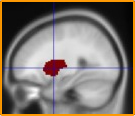
http://www.cs.bris.ac.uk/home/mcgonigl/simproject/ (link not active)
- Reason for cell death is not known
- Symptoms
- Early - (all are "movement" related) shaky hands, rigidness of the body, problems with walking, specifically related the gait
- Further symptomatic development - lose of thinking skills mixed with behavioral problems eventually leading to dementia

- Usually this disease occurs with individuals that at least 50 years old and in an advanced stage the patient will have the above stature
- Parkinsonism syndrome
- This disease is generally considered idiopathic, however, there have been some studies that link it genetically
- Increased risk is noticed with smokers and exposure to certain pesticides
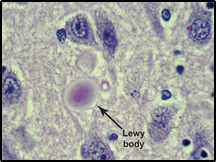
- Two pathological characteristics are (1) the lack of dopamine and (2) the development of Lewy bodies within the neurons. Generally, the greater the amount of Lewy bodies the greater the symptoms
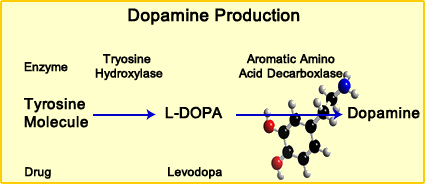
- Parkinson effects the production of dopamine at the presynaptic site. DaT Scan tracer is picked up at the presynaptic site. The reduction DaT is an indication of Parkinson's disease
- What is Dopamine
- Tyrosine is an amino acid that in the presences of tryosine hydroxlase will convert to L-DOPA
- Fact about L-DOPA and Dopamine - dopamine breaks down quickly and for for that reason treatment of Parkinson's disease is done with L-DOPA.
- L-DOPA does not easily breakdown and is easily convert to dopamine when it arrives in the brain
- Conversion to Dopamine occurs when the aromatic amino acid decarboxylase is present
- Dopamine has several characteristics
- It is a neurotransmitter and helps move messages between synapses of the brain
- When a message needs to be sent the pre-synaptic area dopamine is produced. At the post-synaptic end there are 5 different types of receptors that can receive the message
- This is also referred to as the pleasure molecule. Positive stimuli generates increased levels of dopamine
- In the area of the substantia nigra dopamine is associated with movement. Hence movement disorder is associated with PD
- Pathophysiology of Ioflupane
- Comment regarding Ioflupane - is an analog of cocaine and WAS strictly regulated by the FDA and controlled by the DEA. It is classified as a Schedule II drug. Other drugs within the class include (not limited to) opiates and stimulants. The requirement for additional licensing by the physician is no longer mandated
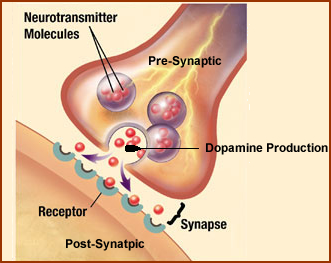
- Concept of up regulation and down regulation
- Look at what is being regulated and associate these terms, if Dopamine
- .. is over produced of dopamine causes decrease in the post-synatic sites causing "down regulation"
- .. not enough dopamine being produced causes the mid-brain to increase the amount of receptors at the post-synaptic site. This is referred to as "up regulation"
- PD results in a loss of dopamine producing neurons at the pre-synaptic site, specifically dopamine transporters (DaT) causing a decrease in DAT production2
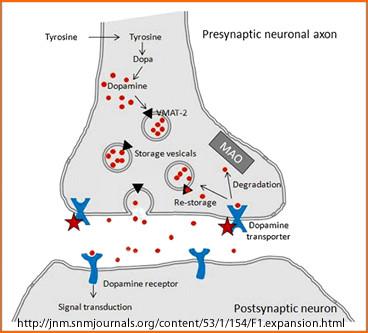
- What is the role of DaT
- It is a sodium chloride-depend transmembrane protein located at the pre-synaptic dopaminergic nerve and controls the production of dopamine
- Initially released at the pre-synaptic site, DaT interacts with the dopamine receptor and then return to the pre-synaptic site
- Hence regulating dopamine production
- In PD is the problem with up or down regulation?
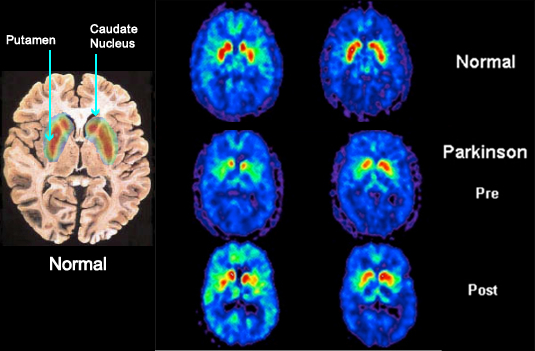
- Uptake of 123I-FP-CIT occurs in areas of high DaT concentration which is located mostly in the stratum of the basal ganglia. This includes the caudate nucleus and the putamen
- Diseases
- DaT Scan is able to identify, but not differentiate between Multiple System Atrophy, Supranuclear Palsy, or Parkinson's disease
- Other neurological conditions that mimic PD but will not be associated with DaT production
- Post encephalitic parkinsonism
- Essential tremor
- Multiple infarct state
- Drug-induced parkinsonism
- Procedure
- This procedure must be strictly adhered per FDA

- Prior to the ordering GE must test your
SPECT system
with brain phantom that contains putamen and caudate nuclei type structures. It is filled with 123I and acquired, processed, and evaluated
- Patient Injection3
- One hour before the injection dose the patient with 100 mg potassium iodine (Lugol's solution)
- 123Ioflupane is calibrated for 12N = 5 mCi therefore suggest administering should occur around this time
- Administer IV
- Patient setup and acquisition3
- Dose 3 - 5 mCi
- Acquisition can be started 3 - 5 hours post administration
- Secure the patient's head to the imaging table with tape
- Positioning can be difficult and you might cut off the base of the brain (is that a problem?)
- Dual or triple headed camera
- Collimator - fan beam or HR or UHR
- Window set at 159 @ 10%
- Circular orbit should be as small as possible, recommend 11 to 15 cm radius
- 360o acquisition with at 3o per stop ~Stops - 120
- Matrix - 128 x 128
- Acquire a 30 to 45 minute scan>
- 1.5 million counts should be collected (documentation is unclear if this is per slice or total counts)
- 1.23 zoom - pixel size should be 3.5 to 4.5 mm
- Processing3
- Iterative approach- 12 iterations with 8 subsets
 Backprojection approach - Butterworth of 8 and a cutoff frequency of 0.6
Backprojection approach - Butterworth of 8 and a cutoff frequency of 0.6- Attenuation correction with Chang set at 0.11cm
- For a more detailed analysis on DaTscan go to http://us.datscan.com/imaging_atlas/. You will need to register in order to get in
- Example of DaT Scan
From more examples, including the one above, visit http://www.rad.kumc.edu/nucmed/clinical/datscan.htm
Return to the Table of Content
10/23
4. Transmembrane Transporters
Author: Quick, Michael W. Date: 2002








 Backprojection approach - Butterworth of 8 and a cutoff frequency of 0.6
Backprojection approach - Butterworth of 8 and a cutoff frequency of 0.6